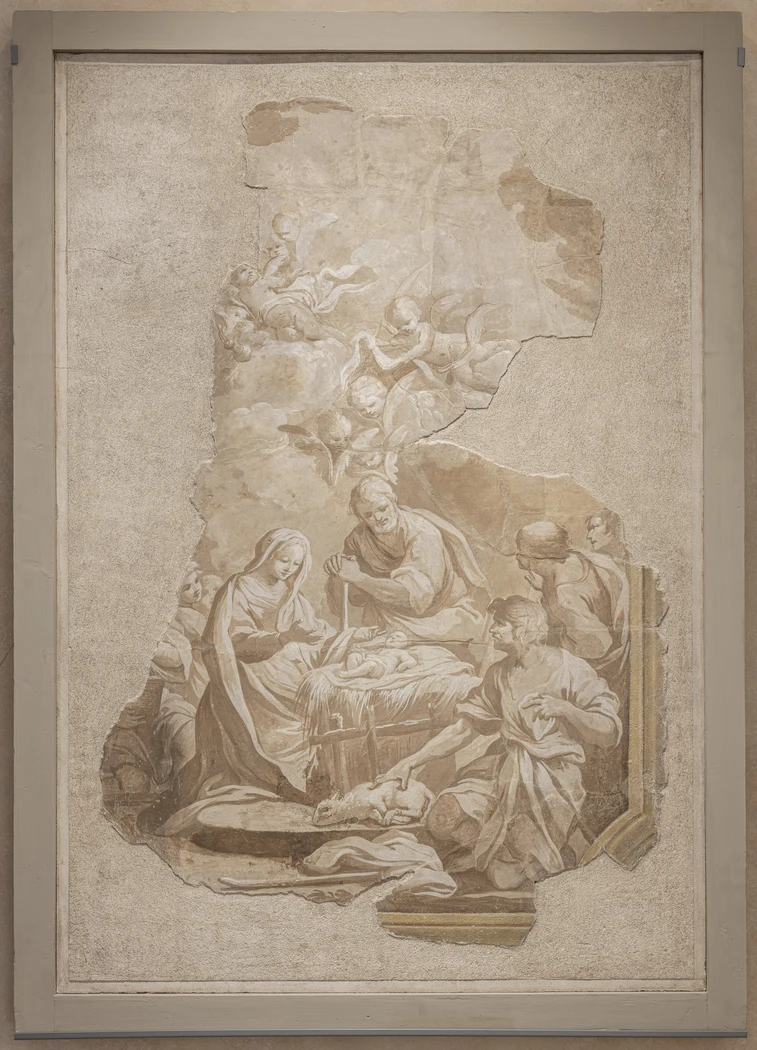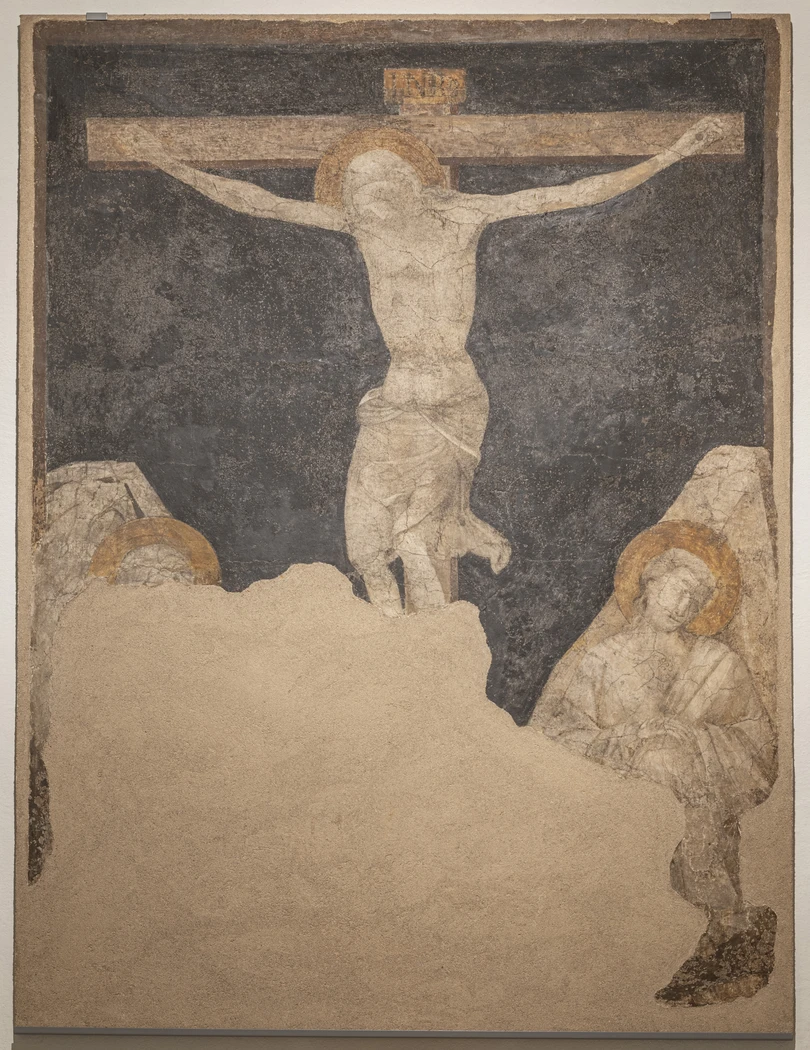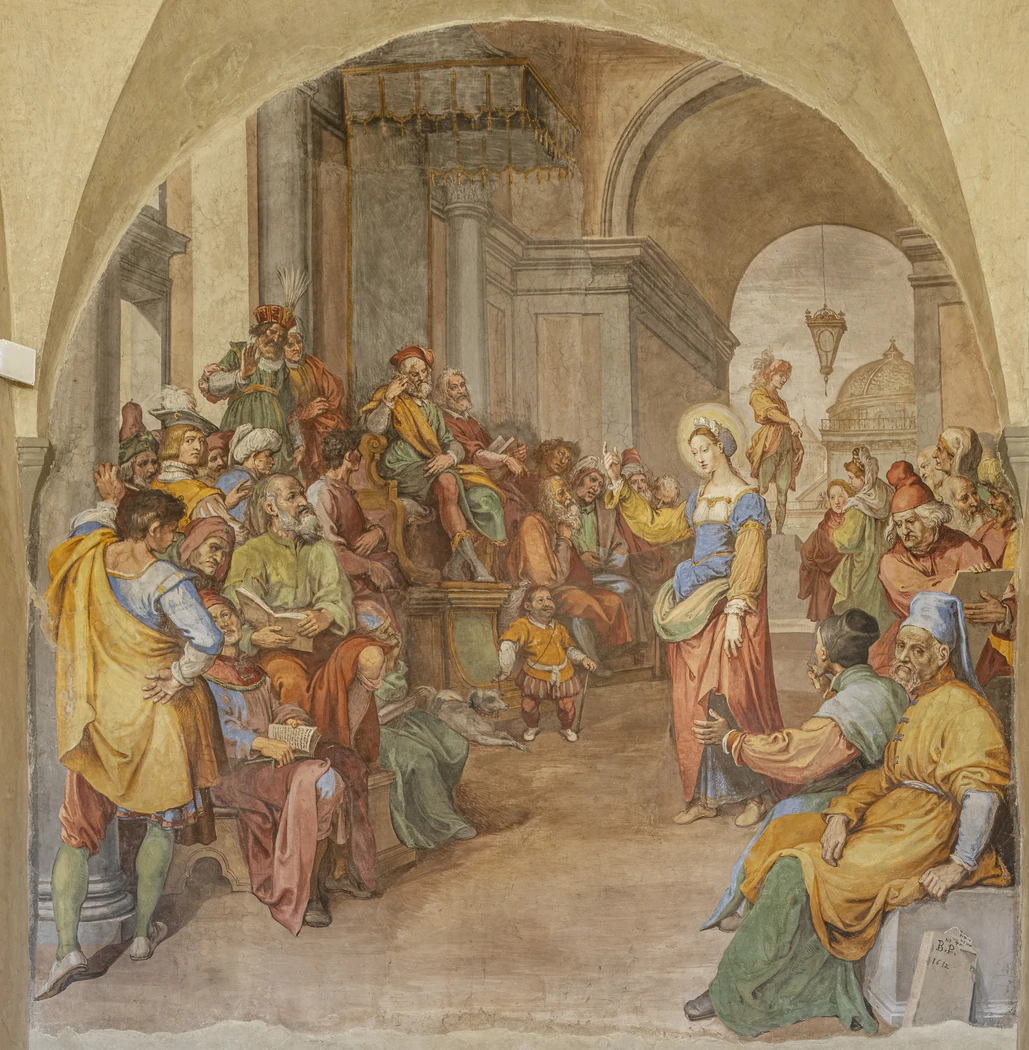Galleria degli Affreschi

The Galleria degli Affreschi and the Prior's Rooms are located along the inner quadrangle of the architectural complex of theIstituto degli Innocenti, above the Cortile degli uomini. Over the centuries they have served various functions by housing uffici and other activities of the administration. In 1971 a nucleus of detached sinopites and frescoes received on deposit by the Soprintendenza alla Gallerie fiorentine-now the Uffizi Galleries-following the Florence Flood of 1966 were placed there.
There are a total of twenty-eight works kept in the Gallery. These consist of twenty-seven works including detached sinopites and frescoes in storage and Bernardino Poccetti's Dispute of Saint Catherine of Alexandria with Philosophers owned by the Institute. Many of these, dating from around the 13th to the 18th century, had until then been kept at the Cenacolo di San Salvatore in Ognissanti. Following the Flood, they were restored and entrusted to the Institute, in conjunction with the relocation and reorganization of the Museo degli Innocenti on the second floor, of which they became an integral part.
The Gallery's exhibition itinerary follows a primarily chronological and thematic order, with a layout that enhances the collection and encourages close viewing of the works, thanks to their placement on the wall at a 'lowered' height and preserves, where possible, the previous placements as evidence of the reading offered by time. Information panels narrate the spaces and works, focusing on two particularly significant nuclei, the pictorial cycle from the second half of the 16th century by Alessandro Allori and workshop and two valuable wall paintings by Lorenzo Monaco dated to the early 15th century.
Historical background
On November 4, 1966, the flood swept through the city, even coming to submerge the basement of theIstituto degli Innocenti The existence of an earlier project for the architectural and functional restoration of the monumental complex, drawn up by the Superintendent of Artistic Monuments, enabled the Administration to carry out timely restoration and enhancement work.
On this occasion, the Museum was moved from the ground-floor premises to the present Pinacoteca and the windowed gallery, identified as the Galleria degli Affreschi, was restored. Following the flood, some detached sinopites and frescoes were entrusted to the Institute along with other secured works. The Pinacoteca and Gallery were inaugurated on June 27, 1971, in the presence of the authorities of the Italian state and the Government of Canada, which contributed to the restoration, testifying to the central role played by Florence in the so-called "revolution in conservation" of works of art. Thanks to the restorations at the time, from the Gallery it is possible to admire the wall decorations in the Cortile degli uomini - executed in white lime and graffito - representing putti in bands, coats of arms of the Institution and of other ancient Florentine hospitals that passed under the administration of the Innocenti.
The works in the Gallery
Of particular importance is the pictorial cycle created by Alessandro Allori and workshop for the chapel of the Ospedale delle Donne in Santa Maria Nuova in 1576, with episodes from the Old Testament and six monumental figures of prophets, which hark back to Michelangelo's frescoes in the Sistine Chapel in the Vatican.
The most recent work dates from the 18th century and depicts a 1monochromeAdoration of the Shepherds.

The Gallery leads to the environment of the small oratory commonly referred to as the Little Chapel o Sisters' Chapel which was built in 1955, after the inner chapel-situated in the Cortile delle Donne used as a classroom for the School of Child Care. As a result of this change of use, the Florentine Curia obtained from the Amministrazione degli Innocenti the construction of a "simple and functional oratory" for the Sisters of Santa Marta, who had been residing at the Institute since 1938 performing various welfare functions.
The oratory was consecrated on Dec. 1, 1956, by Don Attilio Piccini, pastor and archivist of theIstituto degli Innocenti, delegated by the Curia for the celebration. The small chapel was dedicated to the Most Holy Crucifix, presumably because of the presence above the altar of a 16th-century wooden crucifix. The space, entirely renovated with the rediscovered view of the Church of Santa Maria degli Innocenti, now houses some of the most valuable detached frescoes in storage at the Museo degli Innocenti since 1971, including two notable works by Lorenzo Monaco (Piero di Giovanni, Florence, documented 1391-1422).
The fresco depicting a Crucifixion with the Madonna and St. John the Evangelist (2) (1400-1410) was probably made for the Convent of the Oblates of Santa Maria Nuova and features an iconography common in places of care and burial, with St. John and the Madonna sitting on the ground at the foot of the Cross. The figures of the mourners, rendered in only shades of gray, invite meditation on the themes of suffering and comfort.

Similar characters are also presented by the intense depiction of the Christ in Pity (3) (1411-1413), the execution of which has instead recently been traced back to the lost Oratory of the Alberti family in the Camaldolese monastery of Santa Maria degli Angeli in Florence. The exceptionality of this work, conceived as a mural antependium (the covering of the front of the altar), lies in the choice of fresco painting instead of the more common painted panel.

One wing of the Gallery is devoted to sinopites and in-depth study of fresco making and restoration techniques. There are 15th-century works by Bicci di Lorenzo (Madonna and Child between St. John the Baptist and Holy Monk, St. Anthony Abbot; Madonna and Child between Saints Leonard and George) and the 17th-century Last Supper by Matteo Rosselli.
In the entrance vestibule to the Prior's Rooms, it is possible to admire Bernardino Poccetti 's fresco with The Dispute of Saint Catherine of Alexandria with Philosophers (4), painted in 1612. This is the last in a series of works executed by the artist during the period in which he was a guest of the Innocenti, including the celebratory frescoes of the Medici family in the façade loggia and, above all, the History of the Innocents which is located on the ground floor in the space now called precisely "Sala Poccetti."

Conservation and research interventions
Preliminary to the work, the detached frescoes in the Gallery were removed from the walls where they were located and temporarily housed in an internal area specifically designated for storage. Both the works in the collection and Bernardino Poccetti's fresco executed in the vestibule preceding the Prior's Rooms underwent a thorough extraordinary maintenance operation consisting of various types of cleaning, consolidation and pictorial retouching. A new bracket system was then made.
The intervention, constituted an important research opportunity for the Archives, Museum and Cultural Activities Service for the purpose of developing the museological project, providing an opportunity for the initiation of new studies on the works of the fresco collection. The collaboration with the SAGAS Department of the University of Florence has enabled the drafting of the information apparatus and is implementing the web platform that will collect and make in-depth content on the Gallery's works available online.
Accessibility and tools
The redevelopment work, which promoted the physical accessibility of the spaces, was accompanied by actions and tools designed to ensure and improve the enjoyment of the visitor route by special audiences.
The tactile tour route for the visually impaired and blind, until now focused on a few works placed in the History Itinerary, has been enriched by the presence of two tactile reproductions in four-color and braille. The first is dedicated to the fresco Dispute of Saint Catherine of Alexandria by Bernardino Poccetti and is located in the vestibule in front of the Prior's Rooms, while the second is located in the Pinacoteca and concerns the famous Putti in fasce by Andrea della Robbia. To promote accessibility for people with intellectual disabilities, a new guide for facilitated reading of the Museum, which also includes of the Galleria degli Affreschi.
In order to improve inclusivity and accessibility, the signage of the entire museum itinerary has been renewed, while the Galleria degli Affreschi has been equipped with information panels and captions of the works, respecting their legibility and comprehension.
The redevelopment project
In August 2023, the redevelopment project was submitted and obtained funding under the Ministry of Culture's project PNRR M1C3-3 / Investment 1.2, for the "Removal of Physical and Cognitive Barriers in Museums, Libraries and Archives," thanks to which, together with the Institute's own resources, it was possible to carry out the work to make the spaces of the Galleria degli Affreschi fully accessible and usable and the interventions for the enhancement of the heritage of works kept here.
In addition to the Galleria degli Affreschi, the redevelopment work also involved the Little Chapel of the Sisters, rediscovering its privileged view of the church of Santa Maria degli Innocenti, and the two Prior's Rooms. The latter have been completely renovated, furnished and equipped with the necessary technologies for holding cultural activities and small exhibition events.



